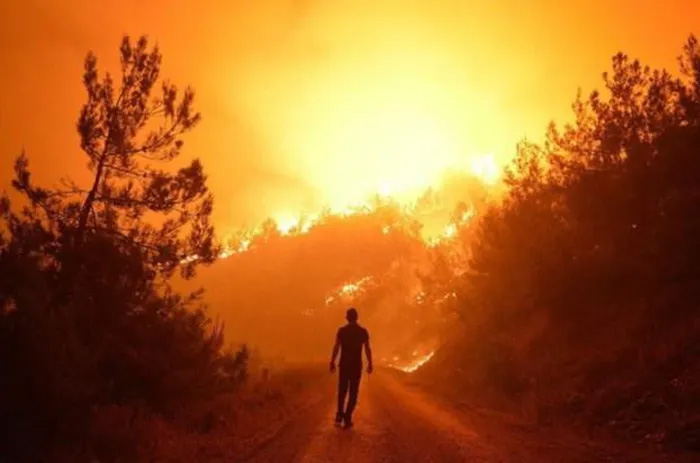Why is the heat getting worse day by day?
A study published in the January 6 issue of Communications Earth and Environment has shown that most countries on Earth are likely to experience extreme heatwaves with a frequency of two years each year. 2030.
The study, which combines data on past emissions and emissions reduction commitments, comes ahead of the 26th Conference of the Parties to the United Nations Framework Convention on Climate Change (COP26) of the United Nations Framework Convention on Climate Change (COP26). The world's five largest emitters (including China, the United States, the European Union, India and Russia) to produce forecasts of regional warming by 2030.
The researchers found that 92 percent of the 165 countries studied were at risk of experiencing extreme heat more often.
If in the pre-industrial period, extreme heat was experienced every 100 years, then by 2030, the frequency will increase to every 2 years.

Global warming causes many disasters.
To assess the impact of emissions from the world's five largest emitters, the researchers analyzed climate models without their emissions dating back to 1991. The Intergovernmental Panel on Climate Change (IPCC) is warning governments for the first time about human-caused climate change. They found that in this model, the proportion of countries experiencing extreme heat years decreased by 46%.
Lead author of the study, Lea Beusch of the Institute of Climate and Atmospheric Sciences at ETH Zurich University (Switzerland), said the study showed that the actions of the world's largest emitters can negative impact on climate at the regional scale.
According to Ms. Beusch, the world often talks about emissions or theoretical global temperatures that humans can hardly feel.
However, she stressed that regional climate change will be more noticeable as 'we are experiencing rising temperatures in our country and experiencing years of frequent extreme heat. than'.
The researchers found that the greatest impact of heat extremes occurs more frequently in Africa, which is predominantly tropical. However, the overall temperature increase is highest in the high-latitude regions of the North, which warm at a faster rate than the tropics.
Even so, the study authors say the frequency of extreme heat years could change if countries step up efforts to cut emissions.
According to the United Nations Framework Convention on Climate Change, with current policies, global emissions will increase by 13.7% by 2030, the time when the world needs to halve emissions to can achieve the goal of limiting the increase in Earth's temperature to 1.5 degrees Celsius under the Paris Agreement on climate change.
According to the head of the Pierre-Simon Laplace Institute, climatologist Robert Vautaud, each terrible heat wave rages on a large scale, causing thousands of deaths and the worrying thing is that these heat waves are increasing day by day. .
A draft United Nations report says that if the world's temperature rises 2 degrees Celsius, a quarter of the world's population could face severe heat waves at least once in five years. .
In the context of severe heat waves becoming more and more a reality of life globally, many people are putting their hopes on the next COP26. According to United Nations Secretary-General Antonio Guterres, the upcoming conference must mark a turning point in efforts to combat climate change.
To do that, every country in the world must commit to net zero emissions by 2050 and submit clear, credible long-term strategies to achieve this goal.
- Australia record hot, the sea into a 'hot pot' cooked many creatures
- Why does steam cause burns worse than boiling water?
- Danger when temperatures rise
- VN: Synthesis of heat to heat
- Oral heat - causes, symptoms and cures
- The shocking truth about human heat tolerance
- Scary underground effects of heat: 'Disable' important body functions
- Effective solution against heat on the terrace
- How to handle common disasters caused by heat
- Solar storms are getting worse
- Burns skin - Things to know
- How do vampire bats suck blood?
 'Fine laughs' - Scary and painful torture in ancient times
'Fine laughs' - Scary and painful torture in ancient times The sequence of numbers 142857 of the Egyptian pyramids is known as the strangest number in the world - Why?
The sequence of numbers 142857 of the Egyptian pyramids is known as the strangest number in the world - Why? History of the iron
History of the iron What is alum?
What is alum? Climate change makes Philippines at double risk of typhoons
Climate change makes Philippines at double risk of typhoons  Strange Antarctic animal can live up to 11,000 years
Strange Antarctic animal can live up to 11,000 years  Strange 'cold tongue' phenomenon is happening in the Pacific Ocean, scientists have not explained it yet
Strange 'cold tongue' phenomenon is happening in the Pacific Ocean, scientists have not explained it yet  El Niño and La Niña have occurred over the past 250 million years.
El Niño and La Niña have occurred over the past 250 million years.  Global rainstorms tied to unusually wet September
Global rainstorms tied to unusually wet September  Why could 2024 be the hottest year in history?
Why could 2024 be the hottest year in history? 